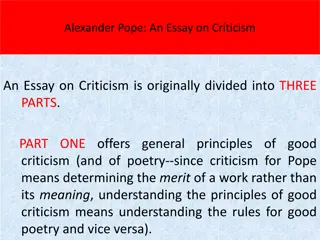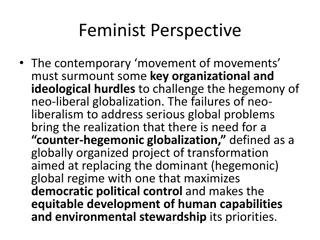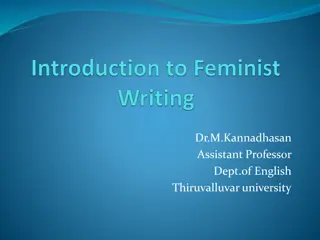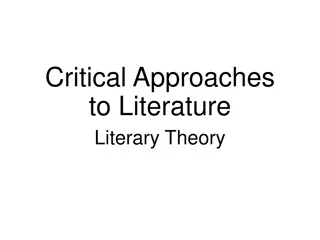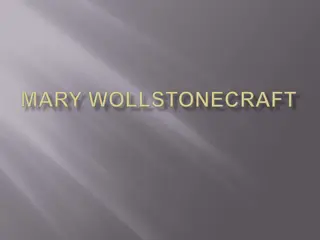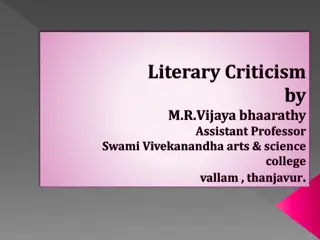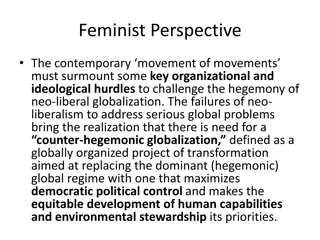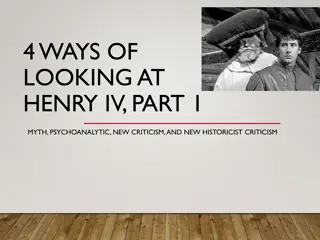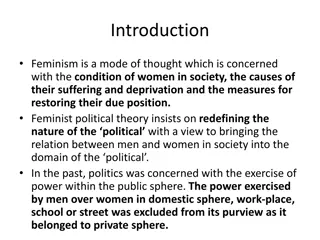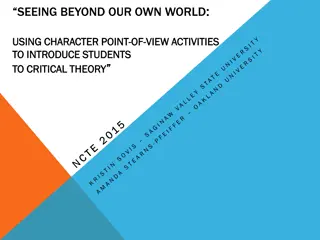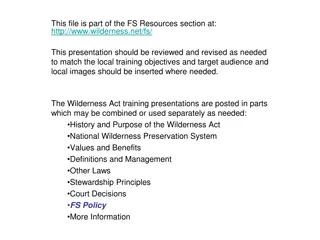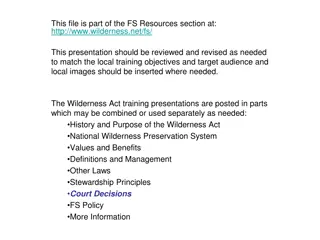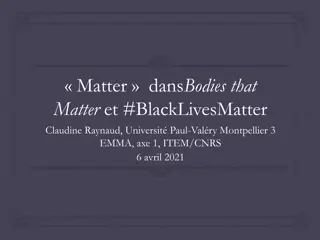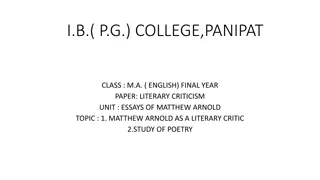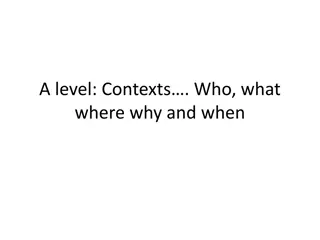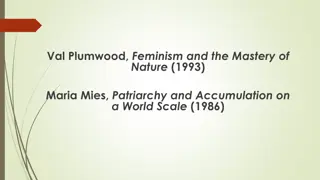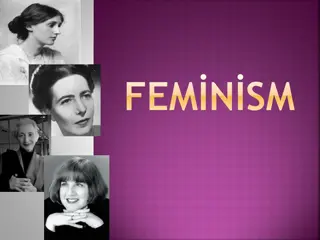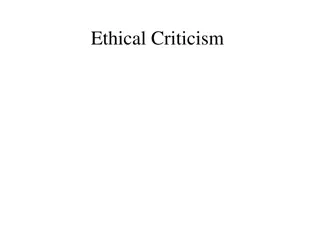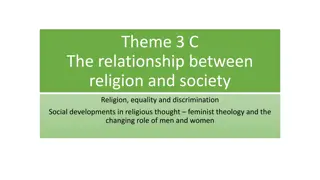Feminist Criticism in the Wilderness by Elaine Showalter - Analysis
Elaine Showalter's essay "Feminist Criticism in the Wilderness" delves into the realm of feminist literary critique, addressing the diversity among women writers and emphasizing the importance of considering factors beyond gender. Showalter highlights the challenges and goals of feminist criticism while exploring the dichotomy between past errors and imaginative beauty. She introduces terms like gynocritics to explore the complexities of defining femininity in women's writing, examining history, styles, themes, genres, and creative structures unique to female writers.
Download Presentation

Please find below an Image/Link to download the presentation.
The content on the website is provided AS IS for your information and personal use only. It may not be sold, licensed, or shared on other websites without obtaining consent from the author.If you encounter any issues during the download, it is possible that the publisher has removed the file from their server.
You are allowed to download the files provided on this website for personal or commercial use, subject to the condition that they are used lawfully. All files are the property of their respective owners.
The content on the website is provided AS IS for your information and personal use only. It may not be sold, licensed, or shared on other websites without obtaining consent from the author.
E N D
Presentation Transcript
FEMINIST CRITICISM IN WILDERNESS(ELAINE SHOWALTER) MA IV SEM PAPER XIII DEPARTMENT OF ENGLISH GOVT COLLEGE PAONTA SAHIB
In her essay Feminist Criticism in the Wilderness (1981), Showalter says, "A cultural theory acknowledges that there are important differences between women as writers: class, race, nationality, and history are literary determinants as significant as gender
Showalter has written and edited numerous books and articles focused on a variety of subjects, from feminist literary criticism to fashion, sometimes sparking controversy, especially with her work on illnesses. Showalter has been a television critic for People magazine and a commentator on BBCradio and television. She is a recipient of the Truman Capote Award for Literary Criticism.
Feminist Criticism in Wilderness The essay by Elaine Showalter is an attempt to study the field of literary criticism from the feminist point of view. Showalter has tried to study the various aspects of feminist criticism while also pointing out the aims it should be trying to attain, the problems it faces and the reasons for these problems.
1. Pluralism and the Feminist Critique Showalter begins this essay by pointing out a dialogue by Carolyn Heilbrun and Catherine Stimpson. They had pointed out that two poles were identifiable in feminist literary criticism- one concentrating on the errors of the past and the other focus on the beauty of imagination. Both these aspects contribute in removing the effects of female servitude that has existed in the society since ages.
2. Defining the Feminine: Gynocritics and the Womans Text It is well accepted that a woman s writing would always be feminine but defining feminine has always been a problem. The second mode of feminist criticism concentrates on this definition. It analyzes women as writers. It undertakes the study of history, styles, themes, genres, and structures of writing by women . It also studies in details the various aspects of female creativity and female literary tradition. Showalter has coined the term gynocritics for the specialized critical discourse that uses women s writings as its exclusive subject. However, identifying the unique elements of women s writings is again a problem. French Feminist Criticism has identified the influence of female body on female language and texts
3. Womens Writing and Womans Body It is one of the clearest statements of gender difference. Theories like that of better developed frontal lobes in case of males and of the use of 20 percent of creative energy for physiological functions in case of women have been used in the past to advocate the superiority of men over women. Many critics have associated the act of creation of text to the generative process which only male used to be considered capable of undertaking. The metaphor of literary paternity used to be associated to penis and, thus, to male.
. Womens Writing and Womans Body It is one of the clearest statements of gender difference. Theories like that of better developed frontal lobes in case of males and of the use of 20 percent of creative energy for physiological functions in case of women have been used in the past to advocate the superiority of men over women. Many critics have associated the act of creation of text to the generative process which only male used to be considered capable of undertaking. The metaphor of literary paternity used to be associated to penis and, thus, to male.
4. Womens Writing and Womens Language This concept analyzes if men and women use language differently while creating texts. It studies if factors like biology, social preferences and cultural beliefs could affect the language of a gender. It also considers the concept of the oppressor s language , the use of language by men to dominate women. For woman, the popular language could be like a foreign language which she is unable to be comfortable with. So, there is a call for development of separate feminine language
5. Womens Writing and Womans Psyche This aspect deals with the connection between author s psyche and creative process in general. The difference in creative process in case of a male and a female is then studied on the basis of this connection. Various psychological theories have suggested that female is inferior in terms of creative capabilities. Critics have been trying to establish new principles of feminist psychoanalysis which would try to differentiate gender identities rather than following Freudian theories. Certain common emotional dimensions could be identified in texts of women writer
6. Womens Writing and Womens Culture The theory of culture as a factor affecting women s writing is inclusive of the theories of biology, language and psyche. The influence of all these factors is guided by the cultural situation of a woman. History has not included female experience. Thus, history is inadequate to understand women s experience. Woman s culture is not a sub-culture of main culture. They are part of general culture itself. If patriarchal society applies restraints on them, they transform it into complementarity. Thus, women experience duality of culture including general culture and women s culture. Women form muted group in society and men form dominant group
Showalter concludes that the promised land or situation when there would be no difference in the texts written by man and woman could not be attained. Attainment of that situation should not be the aim of feminist critics.


